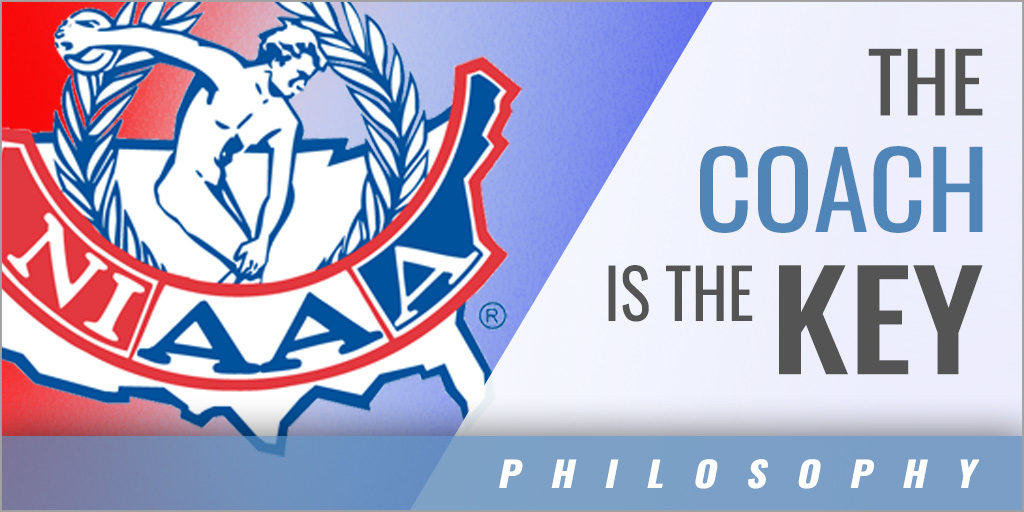|
By: Chris Hobbs, CAA, Ed.S. Introduction: The Influence of Athletics Athletic Administrators are tasked with many roles and one of those roles is effectively casting a vision of coaching excellence. It is common for athletic administrators to interact with parents, faculty-members, administrative colleagues and at times even the occasional coach who 'just don't get it' when it comes to understanding the opportunity that coaches have to positively influence entire communities. The National Federation of High Schools (NFHS) reports that athletic participation has increased for the 26th consecutive year up to almost 8 million high school student athletes (Toporek, 2015). What a great opportunity athletic administrators have to paint a crystal clear picture of what is possible when it is understood that the coach is the key! The Coach is the Key Coaches hold a position of influence inside of schools that is uniquely powerful and unlike any other position (Dougherty, 1972). Interscholastic athletics participation is a choice that students make willingly. Student-athletes sacrifice time, effort, and emotions to be part of athletics teams and with this willing sacrifice comes a commitment and loyalty to the leader of the team: the coach. As a result, coaches have direct influence over a student-athletes enjoyment, self-esteem, and performance (Mata and Gomes, 2013). Additionally, coaching influence goes out beyond just athletic participation and performance. Teacher, guardian, counselor, disciplinarian, mentor, and emotional caretaker are just some of the roles that coaches fill in the lives of their student-athletes (Johnson, Pierce, Tracy, & Ridley, 2015). A Coach's Influence beyond the Parameters of Competition While the influence of a coach in the context of a team and competition makes logical sense, the influence of a coach does not end there. Dougherty (1972) stated that a coach occupies a position of strategic influence in every school on every level of instruction. Many coaches, at times to the discomfort of other educators, yield significant influence in many other areas of a student-athletes life. In fact, successful coaches intentionally yield such influence in a student-athletes life (Johnson, Pierce, Tracy & Ridley, 2015). Literature produces these ideas and in particular three themes of coaching influence emerge: character-development, potential fulfillment via positive feedback, and academic success. Character Development Influence Evidence exists that athletics does not inherently develop character (Camire & Trudel, 2010). Student-athletes enter their athletic experience with expectations that coaches will teach them life skills (Gearity, 2012). Student-athletes also assume that coaches will present high expectations and hold them accountable to meet those expectations (Harris, Hines, Kelley, Williams & Bagey, 2014). Lumpkin and Stokowski (2011) referred to this as the character-building privilege of athletics. Coaches must be intentional about taking advantage of such a unique privilege (Camire & Trudel, 2010). Opportunity to develop character presents itself to coaches at the most challenging of times. Losing games, tension between teammates, media attention, referee decision-making, and academic stress are just a few of the times that the soil for character development is the most fertile. A coach that intentionally uses their influence for character development will successfully fulfill the many expectations that student-athletes and communities place on them. Potential-Realization by Prioritizing the Positive Most athletic administrators are familiar with Mike Krzyzewski (Coach K), the Head Mens' Basketball Coach for Duke University. He has held the position for over three decades, has won five National Collegiate Athletic Association (NCAA) Division I men's basketball championships, and holds the record for most wins in NCAA mens' basketball. Coach K when interviewed about developing leadership in a program highlighted two foundational elements of coach leadership. First, coaches are responsible to help student-athletes prioritize their goals so that they can be successful on and off the court (Sitkin & Hackman, 2011). Second, coaches that assist student-athletes in this way fulfill their responsibility to help young people reach their full potential (Sitkin & Hackman, 2011). Student-athletes arrive at their athletic experience hoping for the best. Not just as it pertains to the goal of winning, but they also hope that their coach will help them grow in to a person they could not have become on their own (Hobbs, 2015). Coaches that want to have a significant impact on student-athletes reaching their full potential should highlight the positive in two meaningful ways. First, student-athletes prefer, readily receive, and respond to positive feedback from their coaches (Gearity, 2012). The athletic and academic experiences in an interscholastic setting are full of built-in methods of negative feedback. Poor test grades, missing a jump shot, or losing a game are all immediate forms of negative feedback. The human spirit is refreshed and prioritizes sources of positive feedback, especially those sources that can maintain a positive perspective even in the midst of stressful situations. Academic Success Literature has much to say about the intrinsic influence that coaches have on the academic performance of their student-athletes. Dougherty (1972) declared coaches as an excellent example of teachers and leaders. Some educators believe that athletics coaching is the last bastion of true academic excellence (Baines & Stanley, 2013). Literature highlights three ways that coaches can push academic success to the forefront of the student-athletes life. First, coaches can require that student-athletes prioritize academic effort (Lumpkin and Stokowski, 2011). Grade requirements for participation, study halls, and tutors are just a few of the ways that academic effort can be prioritized. Second, coaches must demonstrate a positive perspective of academics for their student-athletes (Harris, Hines, Kelley, Williams & Bagley, 2014). A coach can accomplish this by highlighting that academic efforts have a far more significant impact on a person's life than athletic efforts. Third, coaches have to be viewed as working in coordination with the faculty and administration of a school (Harris, Hines, Kelley, Williams & Bagley, 2014). A shared vision of academic success for student-athletes hinges on the coaches willing participation. It is ideal if the coach is perceived as taking the lead on the school campus in highlighting academic efforts. Four Recommendations to Enhance the Influence of a Coach Coaches must model: Modeling is a key to yielding coaching influence responsibly. Coaches must commit to the good that the athletic experience can provide by modeling that which they wish to produce in their student-athletes (Herdman, 2010). The individual that wishes to be called 'coach' must reside themselves to the fact that they cannot separate their own personal character from their role. Coaches must be intentional: Gearity (2012) noted that a good coach demonstrates an intentional mindset by meticulously planning practices and developing positive responses to stress in their student-athletes. The growth of a student-athlete in character, potential, and academic effort will be more fully realized when a coach is intentional about pursuing these ideals. Coaches must be involved: Phil Jackson (2013) stated that he did not love coaching as much as he loved fully immersing himself into something. The influence of a coach actually increases the more involved they become in the lives of their student-athletes (Johnson, Pierce, Tracy & Ridley, 2015). A coach that wishes to leverage their unique position must prepare himself or herself to become fully immersed in the overall development of their student-athletes. Coaches must communicate: A coach's influence is grounded in trust. Trust is enhanced by communication (Bohn, 2015). Communication prior to stress encourages followers to trust; communication during stress validates followers trust. Coaches become stalwarts of influence when they communicate expectations to their student-athletes and then reinforce that communication in the face of challenges. Conclusion Strong emotion is conjured up when a former student-athlete speaks of a coach that properly leveraged their influence for the self-less benefit of their student-athletes. Student-athletes believe that someone will sacrificially give of their time, effort, and emotions to push them to a place they know they cannot achieve on their own. The world of education would be well served to assist interscholastic coaches in meeting such high expectations and fulfilling such high hopes. The world of education would be well served to remember that for almost 8 million students, the coach is the key. References Baines, L., & Stanley, G. (2003). Coaching: Last bastion of academic excellence?.Clearing House,76(4), 217-20. Bohn, P. (2015). Staying the course. Coaching Management 23(6). 14-16. Camire, M., & Trudel, P. (2010). High school athletes' perspectives on character development through sport participation. Physical Education And Sport Pedagogy,15(2), 193-207. Gearity, B. T. (2012). Poor teaching by the coach: A phenomenological description from athletes' experience of poor coaching. Physical Education And Sport Pedagogy,17(1), 79-96. Hardman, A., Jones, C., & Jones, R. (2010). Sports coaching, virtue ethics and emulation. Physical Education And Sport Pedagogy,15(4), 345-359. Harris, P. C., Hines, E. M., Kelly, D. D., Williams, D. J., & Bagley, B. (2014). Promoting the academic engagement and success of black male student-athletes. High School Journal,97(3), 180-195. Hobbs, C. (2015). Take 'em where they can't get themselves. Character and coaching. Retrieved from: http://characterandcoaching.blogspot.com/2015/04/take-em-where-they-cant-get-themselves.html Jackon, P & Delehanty, H. (2013). Eleven rings: The soul of success. New York, NY: Penguin Books. Johnson, J. E., Pierce, D. A., Tracy, D. R., & Ridley, M. J. (2015). The influence of football head coaching change in the football championship subdivision: An evaluation of the ncaa academic progress rate. Journal Of Sport Behavior,38(1), 26-51. Lumpkin, A., & Stokowski, S. (2011). Interscholastic sports: A character building privilege Kappa Delta Pi Record,47(3), 124-128. Mata, R. T., & Da Silva Gomes, A. R. (2013). Winning or not winning: The influence on coach-athlete relationships and goal achievement. Journal Of Human Sport & Exercise,8(4), 986-995. Sitkin, S., & Hackman, J. (2011). Developing team leadership: An interview with coach mike krzyzewski. Academy of Management Learning & Education. 10(3). 494-501. Toporek, B. (2015). High school sports participation eclipses 7.8 million for the first time. Retrieved from: http://blogs.edweek.org/edweek/schooled_in_sports/2015/08/high_school_sports_participation_eclipses_78_million_for_first_time_ever.html |







